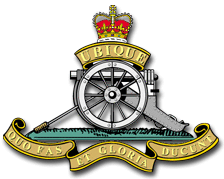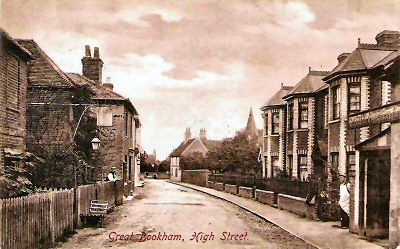
Ashtead War
Memorials - WWI - 2nd Lt Harry (Henry) Albert Millard
58th Battery, Royal Field Artillery

Harry’s father appears to have been Harry Millard, senior, [born at Gosport, Hampshire, registered Alverstoke 6/1869] who in the 1891 Census may be found enumerated as a 21year old Bombardier serving with 3rd Field Battery, Royal Artillery. He is believed to have married, in Malta, “Florrie” ( Florence Micaleff?) before Harry Albert Millard was born there circa 1894.
What is his connection with Ashtead? On 2 August 1883, in Malta, Caroline Micaleff, 18, daughter of Joseph Micaleff, is reported to have married James Clapshaw [sic] [born Chessington, Surrey] aged 34 years, bachelor, Corporal, Royal Artillery, the son of William Clapshaw [IGI indicates James Clapshaw to have been born on 10 June 1849 to Caroline Clapshaw and that he had been christened at Ashtead 8 July 1849.] With his surname correctly spelled Clapshew, James continued in service as a soldier until at least 1891 being included in the Welsh Census for that year with his wife Caroline, born Malta (curiously, “India” is added), in Langyfelach, Glamorgan: they remained childless.
Around 1896, Harry Millard senior died; his widow Florrie stayed in Malta but their child was taken on by James and Caroline Clapshew. The 1901 Census shows that James Clapshew, had become a Beer Seller who lived with his wife, Caroline, and 7 year old nephew, Harry Millard jr (the latter two British Subjects born in Malta) on High Street, Great Bookham. They were still there in 1911 at the Royal Oak. By 1914 the Clapshews had taken up residence at 12 Edenfield Villas, Grove Road, Ashtead.
Teenaged Harry had gained employment in Bookham as an errand boy and Fishmonger’s assistant but, on 15 April 1909, he enlisted, as Henry Albert Millard, with the Royal Field Artillery at Woolwich for 6 years with the Colours and 6 on Reserve, claiming to be 18 years old (about three years older than his actual age). From Gunner he rose rapidly through the ranks being promoted Acting Bombardier on 5 February 1912, Bombardier on 30 October 1912, and Corporal on 17 December 1913. At the outbreak of WWI, 58th Battery RFA was stationed at Woolwich in XXXV Brigade, Eastern Command.
On 20 October 1914, Corporal Harry Millard received a commendation for his gallantry in repairing cut wires under fire at Redinghem and a note to that effect was placed on his personal file, later to lead to some controversy as explained below. He went on became a Sergeant 4 November 1914.
Despite reprimands for neglect of duty and insubordination, he successfully applied for a Commission, to be appointed 2nd Lieutenant with effect from 8 June 1916, and was posted to 7th Division.
On 26 July 1916 at St Giles’ Parish Church, Ashtead, 2nd Lieut. Harry Albert Millard married Cecelia Ann Norris Mudie [born Bermondsey, registered St Olave 9/1893], daughter of James Mudie, deceased. [death registered Bromley 9/1913 aged 47] with J Clapshew as one of the witnesses.
Seven weeks later, as the result of wounds sustained in the battle of Flers-Courcelette, Harry died in No. 5 Casualty Clearing Station based at La Neuville. He was interred at Corbie Communal Cemetery Extension.
The officer’s personal file in the National Archives, WO 339/65146, contains a poignant letter from James Clapshew, dated 26 September 1916, explaining that he and his wife had brought up Harry from the age of 1 year 9 months and they were distraught at the loss of their “boy”. His birth-mother, Florrie Millard, wrote from 67 Ste Tramontania , Valletta, Malta, on 3/10/1916 seeking to retrieve her late husband Harry senior’s medal mentioning her son’s recent marriage and enquiring whether she would be entitled to any benefits as a result of his death.
Cecilia AN Millard, giving her address as 1 Suburban Terrace, Christchurch Road, Chislehurst Road, Orpington, Kent, claimed, 1 October 1916, that her late husband had been awarded a Distinguished Conduct Medal only to be informed that the entry on his conduct sheet related to Redinghem on 20 October 1914 did not result in any decoration. Her belief that there had been a gallantry award possibly accounts for a MM being mentioned in the CWGC record; there was no evidence for this on file nor in Officers Died in the Great War which like CWGC has him as a Lieutenant, which is unlikely given short period between the date of his Commission and his death.
A gold signet ring and other personal effects, including various souvenirs of the conflict, were returned to her.
HA Millard’s Medal Index Card shows that he earned Victory and British Medals with a 1914 Star (Qualifying Date 11 September 1914).
Harry may well also be the Harry Millard on the Great Bookham War Memorial Cross.
| 17 May 2009: Goff Powell author of THE INNS AND PUBLIC HOUSES OF LEATHERHEAD AND DISTRICT (L&DLHS 2006) writes of the The Royal Oak High Street Bookham: Parts of the building date from the 15th century when it probably would have been a beer house for the local farm workers. The name Royal Oak became a very popular tavern name in the 17th century. It is said to have originated from the oak tree in which Charles II hid from the Roundhead soldiers that were pursuing him, after Charles had suffered defeat at the at the Battle of Worcester in 1651. After the restoration of Charles II to the throne, it was declared that May 29th, the king’s birthday, should be celebrated and the day was to be known as ‘Royal Oak Day’. For many years the Swan Brewery owned the public house. It remained a ‘beer only’ house until the mid 1950s when it received a spirit license transferred from a pub in Dorking. |  The Royal Oak, on the left: source Goff Powell collection |
text: Brian Bouchard with contributions by Ann Williams, Goff
Powell and Frank Haslam: if you can add to this page please contact the editor
page added 26 Apr 2009: updated 17 May 2009